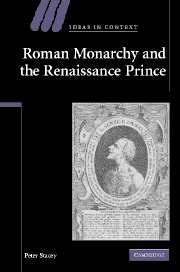Book contents
- Frontmatter
- Contents
- Acknowledgements
- Introduction
- PART I THE ROMAN PRINCEPS
- PART II THE ROMAN THEORY AND THE FORMATION OF THE RENAISSANCE PRINCEPS
- PART III THE HUMANIST PRINCEPS IN THE TRECENTO
- 3 Royal humanism in the Regnum Siciliae
- 4 Princely humanism in the Italian civitas
- PART IV THE HUMANIST PRINCEPS FROM THE QUATTROCENTO TO THE HIGH RENAISSANCE
- PART V THE MACHIAVELLIAN ATTACK
- Conclusion
- Bibliography
- Index
- IDEAS IN CONTEXT
3 - Royal humanism in the Regnum Siciliae
Published online by Cambridge University Press: 22 September 2009
- Frontmatter
- Contents
- Acknowledgements
- Introduction
- PART I THE ROMAN PRINCEPS
- PART II THE ROMAN THEORY AND THE FORMATION OF THE RENAISSANCE PRINCEPS
- PART III THE HUMANIST PRINCEPS IN THE TRECENTO
- 3 Royal humanism in the Regnum Siciliae
- 4 Princely humanism in the Italian civitas
- PART IV THE HUMANIST PRINCEPS FROM THE QUATTROCENTO TO THE HIGH RENAISSANCE
- PART V THE MACHIAVELLIAN ATTACK
- Conclusion
- Bibliography
- Index
- IDEAS IN CONTEXT
Summary
The effect of Petrarch upon the group of lawyers, government officials, teachers and writers in and around Naples which emerged in the 1340s to constitute the first recognisably humanist community in the history of the Kingdom has been captured in a metaphor of conquest by Giuseppe Billanovich. There is little room to doubt the galvanising character of Petrarch's engagement in the intellectual milieu of Angevin Naples. His two visits to the capital in 1341 and 1343, his relationship with King Robert and his correspondence over two decades with various members of the loose coalition of scholars and readers with whom he sustained friendships helped to secure the commitment of certain personnel associated with royal government to the studia humanitatis. The Petrarchan allegiances of the first generation of Neapolitan humanists clearly show their conversion to a ‘nuovo stile di cultura’. Much of the extant Neapolitan correspondence is located within Petrarch's Epistolae Familiares, collected and edited into a definitive redaction by Petrarch himself in 1366. The Neapolitan letters include Petrarch's writings on monarchy. They mark the inception of the long history of European royal humanism. But some of the groundwork for a ready reception of his account of the virtuous prince and the status of those whom he ruled had already been prepared.
- Type
- Chapter
- Information
- Roman Monarchy and the Renaissance Prince , pp. 119 - 144Publisher: Cambridge University PressPrint publication year: 2007

